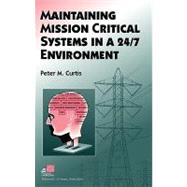
Peter M. Curtis, MS, is the Founder of Power Management Concepts, LLC. He has more than twenty years' experience in mission critical facilities engineering, advising clients in banking, defense, utilities, energy, and education industries.
| Foreword | |
| Preface | |
| Acknowledgments | |
| An Overview of Reliability and Resilience in Today''s Mission Critical Facilities | |
| Introduction | |
| Risk Assessment | |
| Capital Costs Versus Operation Costs | |
| Change Management | |
| Testing and Commissioning | |
| Documentation and Human Factor | |
| Education and Training | |
| Operation and Maintenance | |
| Employee Certification | |
| Standard and Benchmarking | |
| Policies and Regulations | |
| Executive Summary | |
| Introduction | |
| Industry Regulations and Policies | |
| U.S. Patriot Act | |
| The National Strategy for the Physical Protection of Critical Infrastructures and Key Assets | |
| U.S. Security and Exchange Commission (SEC) | |
| Sound Practices to Strengthen the Resilience of the U.S. Financial System | |
| Federal Real Property Council (FRPC) | |
| Basel II Accord | |
| Sarbanes-Oxley (SOX) | |
| NFPA 1600 | |
| Mission Critical Facilities Engineering | |
| Introduction | |
| Companies'' Expectations: Risk Tolerance and Reliability | |
| Identifying the Appropriate Redundancy in a Mission Critical Facility | |
| Improving Reliability, Maintainability, and Proactive Preventative Maintenance | |
| The Mission Critical Facilities Manager and the Importance of the Boardroom | |
| Quantifying Reliability and Availability | |
| Review of Reliability Versus Availability | |
| Design Considerations for the Mission Critical Data Center | |
| Mission Critical Facility Start-Up | |
| The Evolution of Mission Critical Facility Design | |
| Mission Critical Electrical Systems Maintenance | |
| Introduction | |
| The History of the Maintenance Supervisor and the Evolution of the Mission Critical Facilities Engineer | |
| Internal Building Deficiencies and Analysis | |
| Evaluating Your System | |
| Choosing a Maintenance Approach | |
| Standards and Regulations Affecting How Safe Electrical Maintenance Is Performed | |
| Maintenance of Typical Electrical Distribution Equipment | |
| Infrared Scanning | |
| 15-Kilovolt Class Equipment | |
| 480-Volt Switchgear | |
| Motor Control Centers and Panel Boards | |
| Automatic Transfer Switches | |
| Automatic Static Transfer Switches (ASTS) | |
| Power Distribution Units | |
| 277/480-Volt Transformers | |
| Uninterruptible Power Systems | |
| A Final Point on Servicing Equipment | |
| Being Proactive in Evaluating the Test Reports | |
| Data Center Reliability | |
| Standby Generators: Technology, Applications, and Maintenance | |
| Introduction | |
| The Necessity for Standby Power | |
| Emergency, Legally Required, and Optional Systems | |
| Standby Systems that Are Legally Required | |
| Optional Standby Systems | |
| Understanding Your Power Requirements | |
| Management Commitment and Training | |
| Lockout/Tagout | |
| Training | |
| Standby Generator Systems Maintenance Procedures | |
| Maintenance Record Keeping and Data Trending | |
| Load Bank Testing | |
| Documentation Plan | |
| Proper Documentation and Forms | |
| Record Keeping | |
| Emergency Procedures | |
| Cold Start and Load Acceptance | |
| Nonlinear Load Problems | |
| Conclusions | |
| Fuel Systems and Design and Maintenance for Fuel Oil (Howard L. Chesneau, Edward English III, and Ron Ritorto) | |
| Fuel Systems and Fuel Oil | |
| Fuel Supply Maintenance Items | |
| Fuel Supply Typical Design Criteria | |
| Bulk Storage Tank Selection | |
| Codes and Standards | |
| Recommended Practices for all Tanks | |
| Fuel Distribution System Configuration | |
| Day Tank Control System | |
| Automatic Transfer Switch Technology, Application, and Maintenance | |
| Introduction | |
| Overview | |
| Transfer Switch Technology and Applications | |
| Types of Transfer Switches | |
| Bypass-Isolation Transfer Switches | |
| Breaker Pair ATSs | |
| Control Devices | |
| Time Delays | |
| In-Phase Monitor | |
| Programmed (Delayed) Transition | |
| Closed Transition Transfer (Parallel Transfer) | |
| Test Switches | |
| Exercise Clock | |
| Voltage and Frequency Sensing Controls | |
| Optional Accessories and Features | |
| ATS Required Capabilities | |
| Close Against High In-Rush Currents | |
| Table of Contents provided by Publisher. All Rights Reserved. |
The New copy of this book will include any supplemental materials advertised. Please check the title of the book to determine if it should include any access cards, study guides, lab manuals, CDs, etc.
The Used, Rental and eBook copies of this book are not guaranteed to include any supplemental materials. Typically, only the book itself is included. This is true even if the title states it includes any access cards, study guides, lab manuals, CDs, etc.